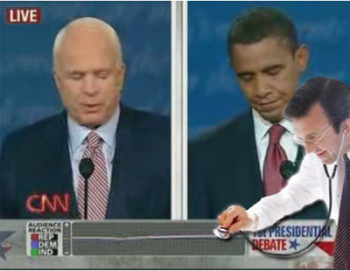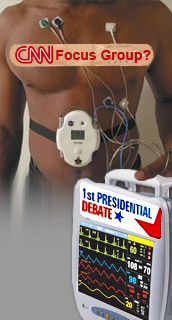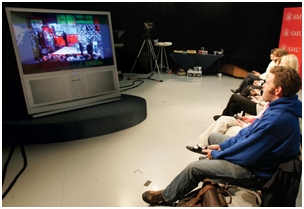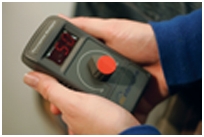
Can't CNN Leave Gismos Alone? Every time I looked at the "Audience Reaction" meter during the debate, it was flat-lined. Were these candidates dead men walking? The sciencey look of the graphic, you must admit, has an appealing truthiness.
| The similarity of CNN’s “Live Audience Reaction” meter to the vital sign monitors in a hospital is unmistakable. Everyone knows from TV –“Doctor, come quickly. Code blue!”– that flat lines in wave form graphics spell death for a hospital patients. But what the heck do the same flat lines mean for viewers watching the presidential debates?
The “Audience Reaction” meter – three colored lines at the bottom of the CNN News screen during the debates – combined with the enforced audience silence to provide a surprising effect: I felt slightly anxious and kept looking for signs of life. Was I watching dying patients in the hospital with the mostly flat-lined and smoothly flowing and colorful wave forms? And what exactly was being measured anyway? My busy CNN television screen did not say. |
 Some bloggers mistakenly thought the audience reaction meter measured pulse rates of the focus group. Here StinkyJournalism illustrates what a focus group member would look like, had it been true. |
Even media bloggers had no clue
MyChances.net asked, “Anyone have any idea how the little scrolling ‘Audience Reaction’ is measured? CNN has one trend-line for independents, republicans, and democrats, and I’m not sure where they’re getting those numbers.”
Speculation abounded on the Web. SteveK on Media Bistro agreed that the meter “is fairly difficult to decipher.”
At Yahoo! Answers, Austin M said, “CNN has chosen 3 audience members to give their reactions to CNN by giving them through a pulse machine. This is possible by seeing their pulse and looking at how it rises and lowers based on the questions asked. Also, those same people have a handheld device where they press 1 of three buttons meaning plus a little, minus a little, or back to neutral. (Used after each question.) Hope this helps.”
Not really, Austin, but thanks.
Dennis left a comment on MyChance.net ” with this CNN link which gives a partial answer: ‘ Voters watch the debate from Columbus, Ohio, and give their reaction to the responses in real-time.’ But how this is done is not clear; nor is it stated how they gauge who is republican, democratic, or independent (presumably self-identification).”
Even the Wall Street Journal ‘s “Numbers Guy” couldn’t enumerate–literally. He wrote, “Beneath the candidates, reaction from 32 undecided focus-group members in Ohio was presented graphically rather than numerically…reaction, positive or negative, was displayed as a rising or falling line.”
The answer was from Ernanio was the best: “They have a bunch of potential voters from OHIO seated in a room with a dial thingamajig on their hands that when rotated can go from 0 – 100 to show how much they are liking the candidates intervention.”
So what does CNN News say?
 “Undecided Democrats participated in a real-time response focus group for CNN on the SMU campus Feb. 21,2008.” Image Source |
I wrote to Edie Emery, in media relations at CNN, seeking answers. She kindly e-mailed me CNN’s press release. It explained (emphasis mine):
“CNN special correspondent Soledad O’Brien will moderate a focus group in Columbus, Ohio. The group will be comprised of a selection of voters from the hotly contested state. During the debate, the participants will operate electronic dial testers that will allow television viewers to see the group’s reactions in real time.”
I still had questions so I wrote back to Ms. Emery. I stated, “Bloggers comments reflect confusion over what exactly the audience reaction meter was doing… Since your Ohio focus group participants were concentrating on what was being said, it was likely difficult for them to remember, on an ongoing basis… to take an extra physical step and actually spin the ‘dial.’ This may explain why very little action (movement in the wave form) was apparent.”
I continued, “From my view, it had the opposite effect as a laugh track. Instead of energizing the viewing experience, it felt like looking at dying patient’s vital signs — flatlined. I kept looking for reactions that were mild at best. This was especially true when combined with the enforced audience silence.”
| Here were my questions and their quick and professional answers–that were still unclear to me:
SJ : Are you going to use this “audience reaction” graphic again? If yes, how did you determine or measure positive (or negative) feedback for the wave form graphic? CNN : Yes, we are going to use the audience reaction graphic again this week. Although we are working on some of the details such as scale, readability, colors of lines, and maybe even the demographic groups we are highlighting. SJ : How many people from each of the 3 political categories groups were in your Ohio focus group that generated the on screen wave form ? CNN : In general these focus groups are about 30 people… We had 32 participating last week. |
Would automatic, instead of manual, measurements of reactions be any better?
I think Austin M, cited above, maybe had the right idea. At least an automatic measurement — like a pulse– would be much more accurate and objective. And it would be a measurement of something real.
But even so, absent an on-screen notice of what is being measured, the occasional and smooth waves only remain a meaningless distraction, not an enhancement of debate. The flat lines encourages viewers’ feelings, and maybe even provides physical evidence, that the whole debate isn’t registering much reaction — of er, whatever the heck it is measuring.
We viewers know what most of the on screen gismos mean on the TV screen. However, due to the importance of the presidential debates, CNN producers should realize now is not the time to be experimenting or ramping up empty calorie polling technology. After all, viewers on the web had no idea — even after researching the CNN site — why they were starring, like a deer in the headlights, at the paradoxically, compelling lack of activity in three wave form lines.
Let’s face it , the CNN “Audience Reaction” meter’s flat lines kept communicating to viewers throughout the debate that the candidates and the wired audience was less than excited about what was being said. I only hope CNN News producers will successfully re-think this dubious polling “invention” before the next debate – and resist any impulse for anymore new on-screen gismos.
Update:
It turns out that the CNN gismos are called “Perception Analyzer Dials,” and the concept was sold to CNN by two Southern Methodist University (SMU) professors, Rita Kirk and Assistant Professor Dan Schill.
Patricia Ward , SMU Magazine, wrote that the professors’ studied “how the public uses blogs, social networking sites and other online tools.” The “idea of giving voters a voice in network coverage through real-time response focus groups” came to them during their research.
Following the vice- presidential debates, we will be able to report on any changes CNN makes in the wave form display. Hopefully, the “do not resuscitate” order has been lifted for Thursday’s debate between Palin vs. Biden.
What was said on CNN before the debates about the meters?
| CNN ELECTION CENTER
Presidential Candidates Prepare to Debate Aired September 26, 2008 – 20:00 ET BLITZER: Soledad, we’re going to be getting back to you. We’re actually going to see how it goes throughout the debate. Now, I want to explain to our viewers what they’re going to be seeing on their screens. And when you see the candidates there, at the bottom of your screens, you’re going to see those dials, those lines moving. The Republican voters, the Democratic voters, the independent voters of that focus group in Columbus, Ohio. It’s going to be in realtime going up or down, and you’re going to get a sense of how these persuadable voters are reacting to what they hear. It’s a feature we want to show you because it will give us an indication of where the candidates are scoring points and not scoring points. |
| THE SITUATION ROOM
Candidates Prepare For Presidential Debate; McCain’s Campaign Gamble Aired September 26, 2008 – 18:00 ET Let’s go to CNN’s Soledad O’Brien. She’s joining us now from Columbus, Ohio — and, Soledad, you’re going to be watching this debate with a select group of voters. Explain what is going on. SOLEDAD O’BRIEN, CNN CORRESPONDENT: We’re going to be joined — sitting behind me — by approximately 30 Ohioans who are registered voters. Approximately a third are registered Independent, a third registered Democrat and a third registered Republican. But what they’re going to have, Wolf, in their hands is this. It’s called a perception analyzer. Now, look, when you turn it to the left, it goes down to one. That would be an indication that they are very unhappy with what they’re hearing from the candidates. They’re all going to have one of these in their hands. And as they watch the debate, they’ll be working this knob here. Turn it all the way to the right, you can go up to 100. That would be an indication that you are very happy with what you’re hearing from the candidate. They’re wireless, of course. All this information fed to a couple of computers down here, which are being manned by two SMU professors who are working on all of these results. Now, what this will be able to tell us is really how the people within these walls here — approximately 30 people — feel about what the candidates are saying, how it’s resonating with them. They’ve all said that they are persuadable. So even though they’re in those categories, they are open to changing their minds. Before the debate begins, they will ask them, how do you feel about each candidate? At the end of the debate, they revisit that question. And it will be an indication of how the debate has changed their thinking, how the debate went. They’ll also declare who they think was the winner. Can you extrapolate that exactly to the rest of the population? No. But to some degree, they are a microcosm of the United States. At the of the day, we’ll be able to see — for other people who say that they are, too, flexible and they could be persuaded, there might be some relevance there. So we’ll be able to see what they think here tonight. And, of course, a couple of days later, overall, what the population thinks about how this debate went for both candidates — Wolf. BLITZER: Soledad, thanks very much. We’re going to be going to you in Columbus and your voters you’re going to be watching with. And I want to show our viewers right now what they’re going to see on the screen during the course of the 90 minute debate, because this is going to be pretty interesting. On the bottom of the screen, you’re going to see those dial- tested — those voters and their dial tests. We’re going to see a running tally, the Republican registered voters, the Democrats, the Independents — what they like and don’t like. And you’re going to see that live unfold in real time, when the two candidates make a point, don’t make a point, they’re going to be — you’re going to see those lines going up and down to get a sense of what those undecided voters believe is going on. And take a look on the two sides. Those of you who are lucky enough to be able to watch us tonight in high definition TV, you’ll see these analyst score cards from our analysts, Paul Begala, Bill Bennett, Gloria Borger, Donna Brazile, Alex Castellanos, John King. You’re going to see where they think the candidates actually made a valid point, made a good point or where they missed an opportunity. The red for McCain, the blue for Obama. And you’re going to be able to get a sense of what’s going on. Those of you who have high definition, you’ll see the analysts’ scorecards. All of you will see the audience reaction at the bottom of the screen tonight in real time live, as that’s going on. We want to check in with Abbi Tatton, also, because there’s some other opportunities out there on the Web to enjoy what’s going on — . |







Comments Terms and Conditions